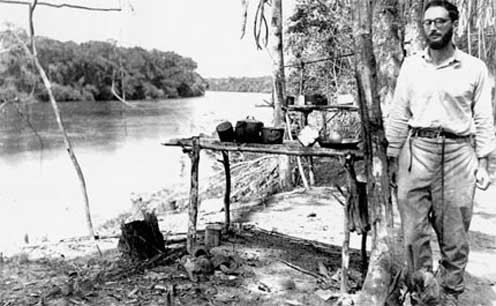
Native classifications are not only methodical and based on carefully built theoretical knowledge. They are also at times comparable from a formal point of view, to those still in use in zoology and botany.
The Aymara Indians of the Bolivian plateau (who may be descended from the legendary Colla to whom the great civilization of Tiahuanaco is attributed) are able experimenters in the preservation of foodstuffs. It was by direct imitation of their technique of dehydration that the American army was able during the [Second World] war to reduce the rations of powdered potatoes sufficient for a hundred meals to the volume of a shoe box. They were also agriculturalists and botanists, and developed the cultivation and taxonomy of the genus Solarium (of great importance to the Indians since they live at an altitude of more than twelve thousand feet where maize will not ripen) further than has perhaps ever been done.
Over two hundred and fifty varieties are still distinguished in native vocabulary and the figure was certainly higher in the past. This taxonomy operates by using a term to designate the variety and adding a qualifying adjective for each subvariety. Thus the variety imilla ‘girl’ is subdivided either according to colour (black, blue, white, red, blood-coloured) or according to other characteristics such as grassy, insipid, egg-shaped and so on. There are about twenty-two main varieties which are subdivided in this way. In addition, there is a general dichotomy between those which may be eaten after simple cooking and those which can only be eaten after being alternately frozen and fermented. A binomial taxonomy also always uses criteria such as form (flat, thick, spiral, like cactus leaf, lumpy, egg-shaped, in the shape of an ox tongue, etc.), texture (mealy, elastic, sticky, etc.), or ‘sex’ (boy or girl) (La Barre).
It was a professional biologist who pointed out how many errors and misunderstandings, some of which have only recently been rectified, could have been avoided, had the older travellers been content to rely on native taxonomies instead of improvising entirely new ones. The result was that eleven different authors between them applied the scientific name Canis azarae to three distinct genera, eight species and nine different sub-species, or again that a single variety of the same species was referred to by several different names. The Guarani of Argentine and Paraguay, on the other hand, work methodically with names composed of one, two or three terms. By this means they distinguish for instance between large, small and medium felines: the dyagua ete is the supreme example of the large feline, the mbarakadya ete of the small wild cat. The mini (small) among the dyague (large) correspond to the guasu (large) among the chivi, that is, the medium-sized felines:
In general, native terms can be said to constitute a well-conceived system, and, with a pinch of salt, they can be said to bear some resemblance to our scientific nomenclature. These primitive Indians did not leave the naming of natural phenomena to chance. They assembled tribal councils to decide which terms best corresponded to the nature of species, classifying groups and sub-groups with great precision. The preservation of the indigenous terms for the local fauna is not just a matter of piety and integrity; it is a duty to science (Dennler, pp. 234 and 244).
... [Later in the book, Levi Strauss discusses Australian Indigenous people.] It is perhaps because [anthropologists] Spencer and Gillen’s material related to a comparatively limited number of Australian tribes and was at the same time remarkably full for each, that they were more acutely aware than their successors of the systematic relations between [concepts in indigenous languages] … The greater our knowledge, the more obscure the overall scheme. The dimensions multiply, and the growth of axes of reference beyond a certain point paralyses intuitive methods: it becomes impossible to visualize a system when its representation requires a continuum of more than three or four dimensions. But the day may come when all the available documentation on Australian tribes is transferred to punched cards and with the help of a computer that their entire techno-economic, social and religious structures can be shown to be like a vast group of transformations.
The idea is the more attractive since it is at least possible to see why Australia should be a particularly favourable field for such an experiment, more so than any other continent. In spite of the contact and inter-change with the outside world which has also taken place in Australia, Australian societies have probably developed in isolation more than appears to have been the case elsewhere. Moreover, this development was not undergone passively. It was desired and conceptualized, for few civilizations seem to equal the Australians in their taste for erudition and speculation and what sometimes looks like intellectual dandyism, odd as this expression may appear when it is applied to people with so rudimentary a level of material life.
Levi-Strauss, Claude. 1966. The Savage Mind. Chicago: University of Chicago Press, pp.42-43, 87-88. || Amazon || WorldCat
